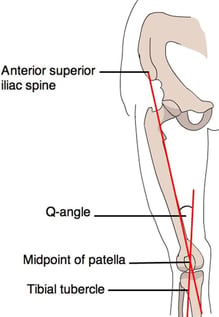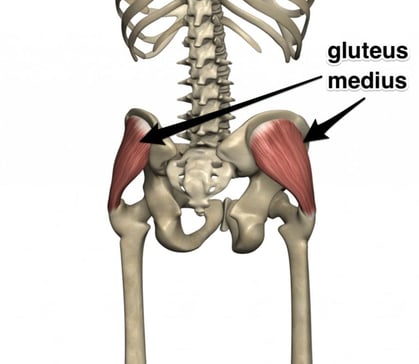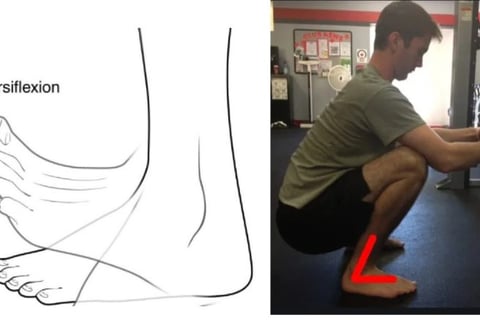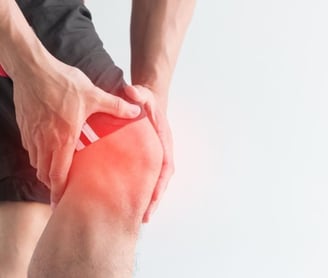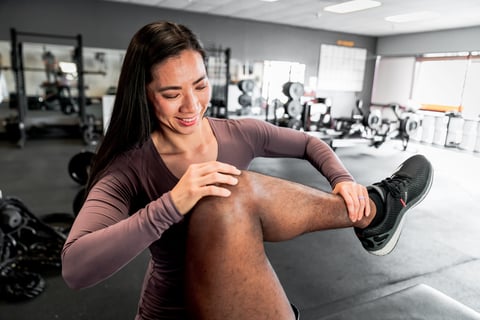Knee Cave When Squatting, Running, or Standing Up
What is it? Why does it happen? Is it bad? And should you fix it?
WHAT IS KNEE VALGUS (KNEE CAVE)?
Knee valgus, aka knee cave, is when the knee collapses inwardly (medially). This is most commonly seen during squats, but can also be seen with exercises such as the lunge, single leg squat, running, landing from a jump, climbing stairs, and even when going from a standing position to sitting and vice versa.
WHAT ARE THE COMMON CAUSES OF KNEE VALGUS?
Q-Angle
Knee valgus can be seen in both men and women, but it is more common in women due to the Q-angle – which is the angle between the front of the pelvis (specifically ASIS) and center of the knee cap (patella). This is the line of force of the quadriceps. Women generally have a wider pelvis which means a greater Q-angle, thus more prone to injury. Q-angles are not only influenced by a wider pelvis, but it can also be associated with the structure and rotation of the femur (thigh bone) and tibia (shin bone).
Gluteus Medius
If you walk around a gym or watch runners running you will certainly see knee valgus during squats in both men and women due to other reasons other than the Q-angle. Another common culprit is having weak or underactive glutes, particularly the gluteus medius. This muscle helps you abduct your leg (brings the leg out to the side), so you can see how sufficient strength and activation of this muscle would help keep your knee from caving in. Underactivitation is actually not a weakness issue but a neuromuscular issue where you have a disconnect between the brain and glute medius muscle and so it won’t fully “turn on” when you need it to.
Angle Dorsiflexion
Insufficient ankle dorsiflexion can also cause knee valgus. Ankle dorsiflexion is the motion of bringing your toes towards your shins. When squatting, you need good ankle dorsiflexion in order to reach the ideal squat depth. When you are limited in ankle dorsiflexion your body will compensate in other ways to get to that depth, such as rolling your ankle inward which then leads to inward caving of the knees.
IS IT IMPORTANT TO FIX KNEE VALGUS?
Continuous knee cave, especially under heavy load places the knee joint at a greater risk for injury. When your knee caves in it puts your knee to be in an unsafe and unstable position. And when you add heavy loads to this position you can only imagine the potential damage you may be causing. This places a lot of stress on the medial (inside) of your knee which can lead to patellofemoral (knee) pain, ACL tears, IT band syndrome, and possibly even arthritis in the long run.
A BONUS to reducing your risk of injury is being able to lift heavier and significantly improve your runs.
HOW TO FIX THIS?
Like any problem, fixing requires you to determine why your knees are caving in in the first place. To do this accurately, it is best to consult with a physical therapist. A physical therapist will be able to conduct a thorough assessment to determine if it is a form issue, gluteus medius weakness/underactivation, and/or limited ankle mobility, etc.
If you feel or know that your knee valgus problem is due to a gluteus medius issue, check out my blog on how to fix this.
PHYSICAL THERAPY
You can be accurately diagnosed by a physical therapist to determine the culprit of your knee valgus. Based on the evaluation, a treatment plan may include:
Technique / form analysis and correction
Strengthening program for weak muscles
Exercises to improve muscular endurance, mobility, and flexibility
Hands-on manual therapy, if indicated
Activity modification
Programming to return to lifting or sport
Look for a physical therapist in your area.
If you are in the San Diego area, schedule with us!
If you’re out of the area, book a virtual visit (telehealth).
Not sure if you need physical therapy, book a FREE 15-minute video/phone chat to find out!
